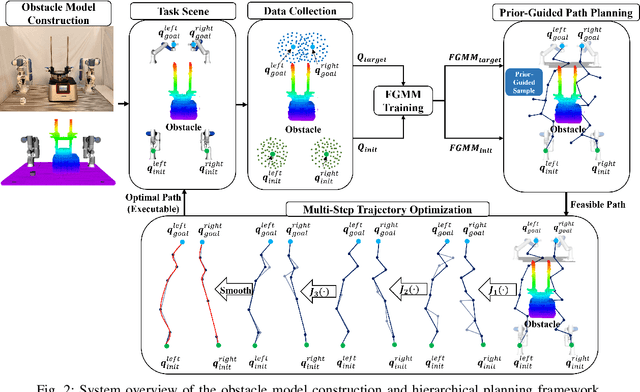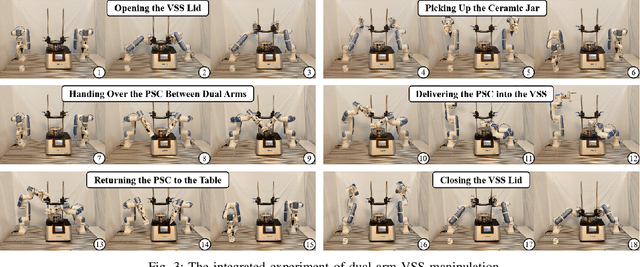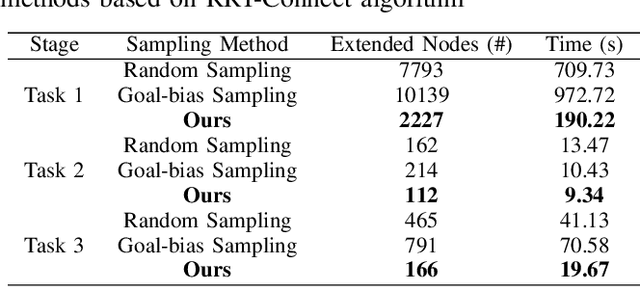Zirui Guo
SAIL-Embedding Technical Report: Omni-modal Embedding Foundation Model
Oct 14, 2025Abstract:Multimodal embedding models aim to yield informative unified representations that empower diverse cross-modal tasks. Despite promising developments in the evolution from CLIP-based dual-tower architectures to large vision-language models, prior works still face unavoidable challenges in real-world applications and business scenarios, such as the limited modality support, unstable training mechanisms, and industrial domain gaps. In this work, we introduce SAIL-Embedding, an omni-modal embedding foundation model that addresses these issues through tailored training strategies and architectural design. In the optimization procedure, we propose a multi-stage training scheme to boost the multifaceted effectiveness of representation learning. Specifically, the content-aware progressive training aims to enhance the model's adaptability to diverse downstream tasks and master enriched cross-modal proficiency. The collaboration-aware recommendation enhancement training further adapts multimodal representations for recommendation scenarios by distilling knowledge from sequence-to-item and ID-to-item embeddings while mining user historical interests. Concurrently, we develop the stochastic specialization and dataset-driven pattern matching to strengthen model training flexibility and generalizability. Experimental results show that SAIL-Embedding achieves SOTA performance compared to other methods in different retrieval tasks. In online experiments across various real-world scenarios integrated with our model, we observe a significant increase in Lifetime (LT), which is a crucial indicator for the recommendation experience. For instance, the model delivers the 7-day LT gain of +0.158% and the 14-day LT gain of +0.144% in the Douyin-Selected scenario. For the Douyin feed rank model, the match features produced by SAIL-Embedding yield a +0.08% AUC gain.
RAG-Anything: All-in-One RAG Framework
Oct 14, 2025Abstract:Retrieval-Augmented Generation (RAG) has emerged as a fundamental paradigm for expanding Large Language Models beyond their static training limitations. However, a critical misalignment exists between current RAG capabilities and real-world information environments. Modern knowledge repositories are inherently multimodal, containing rich combinations of textual content, visual elements, structured tables, and mathematical expressions. Yet existing RAG frameworks are limited to textual content, creating fundamental gaps when processing multimodal documents. We present RAG-Anything, a unified framework that enables comprehensive knowledge retrieval across all modalities. Our approach reconceptualizes multimodal content as interconnected knowledge entities rather than isolated data types. The framework introduces dual-graph construction to capture both cross-modal relationships and textual semantics within a unified representation. We develop cross-modal hybrid retrieval that combines structural knowledge navigation with semantic matching. This enables effective reasoning over heterogeneous content where relevant evidence spans multiple modalities. RAG-Anything demonstrates superior performance on challenging multimodal benchmarks, achieving significant improvements over state-of-the-art methods. Performance gains become particularly pronounced on long documents where traditional approaches fail. Our framework establishes a new paradigm for multimodal knowledge access, eliminating the architectural fragmentation that constrains current systems. Our framework is open-sourced at: https://github.com/HKUDS/RAG-Anything.
Dual-Arm Hierarchical Planning for Laboratory Automation: Vibratory Sieve Shaker Operations
Sep 18, 2025



Abstract:This paper addresses the challenges of automating vibratory sieve shaker operations in a materials laboratory, focusing on three critical tasks: 1) dual-arm lid manipulation in 3 cm clearance spaces, 2) bimanual handover in overlapping workspaces, and 3) obstructed powder sample container delivery with orientation constraints. These tasks present significant challenges, including inefficient sampling in narrow passages, the need for smooth trajectories to prevent spillage, and suboptimal paths generated by conventional methods. To overcome these challenges, we propose a hierarchical planning framework combining Prior-Guided Path Planning and Multi-Step Trajectory Optimization. The former uses a finite Gaussian mixture model to improve sampling efficiency in narrow passages, while the latter refines paths by shortening, simplifying, imposing joint constraints, and B-spline smoothing. Experimental results demonstrate the framework's effectiveness: planning time is reduced by up to 80.4%, and waypoints are decreased by 89.4%. Furthermore, the system completes the full vibratory sieve shaker operation workflow in a physical experiment, validating its practical applicability for complex laboratory automation.
Grasp Like Humans: Learning Generalizable Multi-Fingered Grasping from Human Proprioceptive Sensorimotor Integration
Sep 10, 2025



Abstract:Tactile and kinesthetic perceptions are crucial for human dexterous manipulation, enabling reliable grasping of objects via proprioceptive sensorimotor integration. For robotic hands, even though acquiring such tactile and kinesthetic feedback is feasible, establishing a direct mapping from this sensory feedback to motor actions remains challenging. In this paper, we propose a novel glove-mediated tactile-kinematic perception-prediction framework for grasp skill transfer from human intuitive and natural operation to robotic execution based on imitation learning, and its effectiveness is validated through generalized grasping tasks, including those involving deformable objects. Firstly, we integrate a data glove to capture tactile and kinesthetic data at the joint level. The glove is adaptable for both human and robotic hands, allowing data collection from natural human hand demonstrations across different scenarios. It ensures consistency in the raw data format, enabling evaluation of grasping for both human and robotic hands. Secondly, we establish a unified representation of multi-modal inputs based on graph structures with polar coordinates. We explicitly integrate the morphological differences into the designed representation, enhancing the compatibility across different demonstrators and robotic hands. Furthermore, we introduce the Tactile-Kinesthetic Spatio-Temporal Graph Networks (TK-STGN), which leverage multidimensional subgraph convolutions and attention-based LSTM layers to extract spatio-temporal features from graph inputs to predict node-based states for each hand joint. These predictions are then mapped to final commands through a force-position hybrid mapping.
LightPROF: A Lightweight Reasoning Framework for Large Language Model on Knowledge Graph
Apr 04, 2025Abstract:Large Language Models (LLMs) have impressive capabilities in text understanding and zero-shot reasoning. However, delays in knowledge updates may cause them to reason incorrectly or produce harmful results. Knowledge Graphs (KGs) provide rich and reliable contextual information for the reasoning process of LLMs by structurally organizing and connecting a wide range of entities and relations. Existing KG-based LLM reasoning methods only inject KGs' knowledge into prompts in a textual form, ignoring its structural information. Moreover, they mostly rely on close-source models or open-source models with large parameters, which poses challenges to high resource consumption. To address this, we propose a novel Lightweight and efficient Prompt learning-ReasOning Framework for KGQA (LightPROF), which leverages the full potential of LLMs to tackle complex reasoning tasks in a parameter-efficient manner. Specifically, LightPROF follows a "Retrieve-Embed-Reason process", first accurately, and stably retrieving the corresponding reasoning graph from the KG through retrieval module. Next, through a Transformer-based Knowledge Adapter, it finely extracts and integrates factual and structural information from the KG, then maps this information to the LLM's token embedding space, creating an LLM-friendly prompt to be used by the LLM for the final reasoning. Additionally, LightPROF only requires training Knowledge Adapter and can be compatible with any open-source LLM. Extensive experiments on two public KGQA benchmarks demonstrate that LightPROF achieves superior performance with small-scale LLMs. Furthermore, LightPROF shows significant advantages in terms of input token count and reasoning time.
PathRAG: Pruning Graph-based Retrieval Augmented Generation with Relational Paths
Feb 18, 2025Abstract:Retrieval-augmented generation (RAG) improves the response quality of large language models (LLMs) by retrieving knowledge from external databases. Typical RAG approaches split the text database into chunks, organizing them in a flat structure for efficient searches. To better capture the inherent dependencies and structured relationships across the text database, researchers propose to organize textual information into an indexing graph, known asgraph-based RAG. However, we argue that the limitation of current graph-based RAG methods lies in the redundancy of the retrieved information, rather than its insufficiency. Moreover, previous methods use a flat structure to organize retrieved information within the prompts, leading to suboptimal performance. To overcome these limitations, we propose PathRAG, which retrieves key relational paths from the indexing graph, and converts these paths into textual form for prompting LLMs. Specifically, PathRAG effectively reduces redundant information with flow-based pruning, while guiding LLMs to generate more logical and coherent responses with path-based prompting. Experimental results show that PathRAG consistently outperforms state-of-the-art baselines across six datasets and five evaluation dimensions. The code is available at the following link: https://github.com/BUPT-GAMMA/PathRAG
LightRAG: Simple and Fast Retrieval-Augmented Generation
Oct 08, 2024



Abstract:Retrieval-Augmented Generation (RAG) systems enhance large language models (LLMs) by integrating external knowledge sources, enabling more accurate and contextually relevant responses tailored to user needs. However, existing RAG systems have significant limitations, including reliance on flat data representations and inadequate contextual awareness, which can lead to fragmented answers that fail to capture complex inter-dependencies. To address these challenges, we propose LightRAG, which incorporates graph structures into text indexing and retrieval processes. This innovative framework employs a dual-level retrieval system that enhances comprehensive information retrieval from both low-level and high-level knowledge discovery. Additionally, the integration of graph structures with vector representations facilitates efficient retrieval of related entities and their relationships, significantly improving response times while maintaining contextual relevance. This capability is further enhanced by an incremental update algorithm that ensures the timely integration of new data, allowing the system to remain effective and responsive in rapidly changing data environments. Extensive experimental validation demonstrates considerable improvements in retrieval accuracy and efficiency compared to existing approaches. We have made our LightRAG open-source and available at the link: https://github.com/HKUDS/LightRAG.
Intent-aware Recommendation via Disentangled Graph Contrastive Learning
Mar 06, 2024



Abstract:Graph neural network (GNN) based recommender systems have become one of the mainstream trends due to the powerful learning ability from user behavior data. Understanding the user intents from behavior data is the key to recommender systems, which poses two basic requirements for GNN-based recommender systems. One is how to learn complex and diverse intents especially when the user behavior is usually inadequate in reality. The other is different behaviors have different intent distributions, so how to establish their relations for a more explainable recommender system. In this paper, we present the Intent-aware Recommendation via Disentangled Graph Contrastive Learning (IDCL), which simultaneously learns interpretable intents and behavior distributions over those intents. Specifically, we first model the user behavior data as a user-item-concept graph, and design a GNN based behavior disentangling module to learn the different intents. Then we propose the intent-wise contrastive learning to enhance the intent disentangling and meanwhile infer the behavior distributions. Finally, the coding rate reduction regularization is introduced to make the behaviors of different intents orthogonal. Extensive experiments demonstrate the effectiveness of IDCL in terms of substantial improvement and the interpretability.
* Accepted by IJCAI 2023
GraphEdit: Large Language Models for Graph Structure Learning
Mar 05, 2024Abstract:Graph Structure Learning (GSL) focuses on capturing intrinsic dependencies and interactions among nodes in graph-structured data by generating novel graph structures. Graph Neural Networks (GNNs) have emerged as promising GSL solutions, utilizing recursive message passing to encode node-wise inter-dependencies. However, many existing GSL methods heavily depend on explicit graph structural information as supervision signals, leaving them susceptible to challenges such as data noise and sparsity. In this work, we propose GraphEdit, an approach that leverages large language models (LLMs) to learn complex node relationships in graph-structured data. By enhancing the reasoning capabilities of LLMs through instruction-tuning over graph structures, we aim to overcome the limitations associated with explicit graph structural information and enhance the reliability of graph structure learning. Our approach not only effectively denoises noisy connections but also identifies node-wise dependencies from a global perspective, providing a comprehensive understanding of the graph structure. We conduct extensive experiments on multiple benchmark datasets to demonstrate the effectiveness and robustness of GraphEdit across various settings. We have made our model implementation available at: https://github.com/HKUDS/GraphEdit.
Improving Expressive Power of Spectral Graph Neural Networks with Eigenvalue Correction
Jan 28, 2024Abstract:In recent years, spectral graph neural networks, characterized by polynomial filters, have garnered increasing attention and have achieved remarkable performance in tasks such as node classification. These models typically assume that eigenvalues for the normalized Laplacian matrix are distinct from each other, thus expecting a polynomial filter to have a high fitting ability. However, this paper empirically observes that normalized Laplacian matrices frequently possess repeated eigenvalues. Moreover, we theoretically establish that the number of distinguishable eigenvalues plays a pivotal role in determining the expressive power of spectral graph neural networks. In light of this observation, we propose an eigenvalue correction strategy that can free polynomial filters from the constraints of repeated eigenvalue inputs. Concretely, the proposed eigenvalue correction strategy enhances the uniform distribution of eigenvalues, thus mitigating repeated eigenvalues, and improving the fitting capacity and expressive power of polynomial filters. Extensive experimental results on both synthetic and real-world datasets demonstrate the superiority of our method.
 Add to Chrome
Add to Chrome Add to Firefox
Add to Firefox Add to Edge
Add to Edge